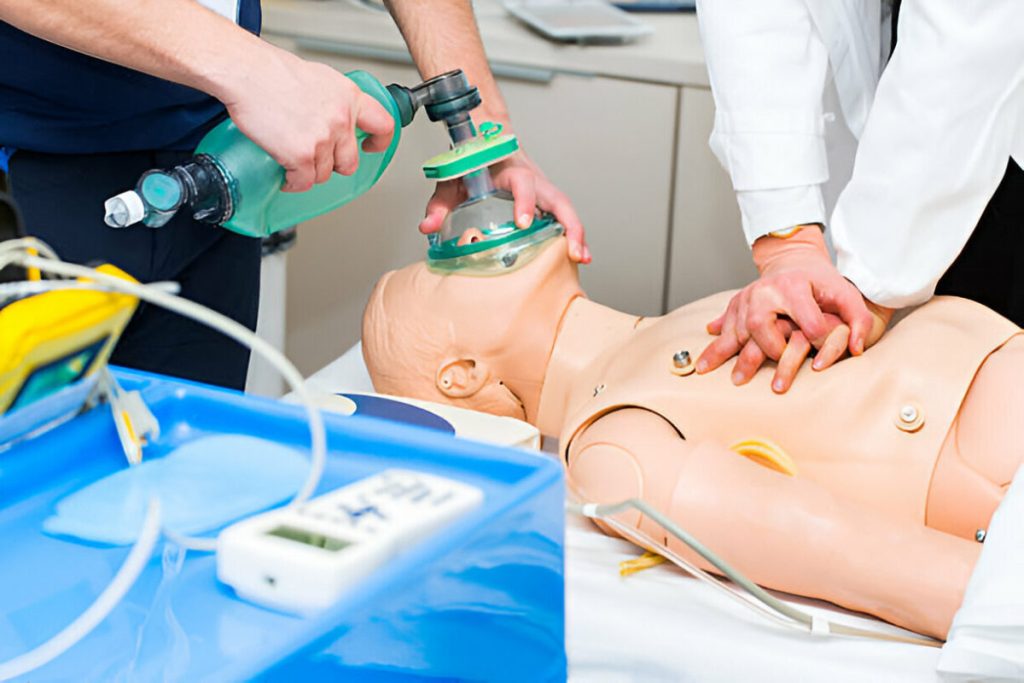When treating a patient in cardiac arrest, achieving Return of Spontaneous Circulation (ROSC) is just the beginning of the journey. The critical moments following ROSC present healthcare providers with a complex diagnostic challenge: identifying and addressing the underlying cause of the arrest. In Advanced Cardiac Life Support (ACLS), the “H’s and T’s” framework serves as a vital cognitive aid for systematically evaluating potentially reversible causes of cardiac arrest. This article explores the importance of thorough post-ROSC assessment and how the H’s and T’s framework guides clinical decision-making during this critical phase of care.
Understanding ROSC in ACLS Protocol
Return of Spontaneous Circulation marks the resumption of perfusing cardiac activity after cardiac arrest. While ROSC represents a significant achievement in resuscitation efforts, it’s essential to recognize that the patient remains in a vulnerable state. According to the American Heart Association, approximately 25-30% of adult patients who achieve ROSC after out-of-hospital cardiac arrest survive to hospital discharge, highlighting the importance of comprehensive post-ROSC care.
ACLS protocols emphasize the need for immediate post-ROSC interventions, including:
- Optimizing oxygenation and ventilation
- Hemodynamic stabilization
- Targeted temperature management when indicated
- Identifying and treating the underlying cause
This final point—identifying the underlying cause—is where the H’s and T’s framework becomes invaluable in guiding clinical assessment and intervention.
The H’s of Cardiac Arrest: Recognition and Management Post-ROSC
Hypoxia
Hypoxia, or insufficient oxygen delivery to tissues, remains a common precipitant of cardiac arrest. Following ROSC, ongoing assessment of oxygenation is crucial. Continuous pulse oximetry, arterial blood gas analysis, and careful attention to ventilation parameters help identify persistent hypoxia.
Post-ROSC management strategies include:
- Titrating FiO2 to maintain SpO2 between 94-98% (avoiding hyperoxia)
- Evaluating for underlying lung pathology
- Considering mechanical ventilation strategies appropriate for the patient’s condition
Hypovolemia
Volume depletion can significantly compromise cardiac output and trigger arrest. Clinical signs of hypovolemia may become more apparent post-ROSC and include:
- Tachycardia with hypotension
- Poor peripheral perfusion
- Decreased jugular venous pressure
- Low central venous pressure (if monitored)
Fluid resuscitation should be guided by clinical response and, when available, dynamic parameters of fluid responsiveness. In cases of hemorrhagic hypovolemia, blood product administration and source control become priorities.
Hydrogen Ion (Acidosis)
Acidosis, particularly metabolic acidosis, can develop during cardiac arrest due to anaerobic metabolism and lactic acid production. While CPR helps mitigate acidosis by providing some tissue perfusion, significant acidemia often persists post-ROSC.
Arterial blood gas analysis guides management, which may include:
- Ensuring adequate ventilation to correct respiratory acidosis
- Optimizing tissue perfusion to clear lactate
- Judicious use of sodium bicarbonate in severe acidosis (pH < 7.2) with adequate ventilation
Hypo/Hyperkalemia
Electrolyte disturbances, particularly potassium abnormalities, can trigger cardiac arrest by affecting myocardial electrical activity. Post-ROSC, immediate laboratory assessment of electrolytes is essential.
For hypokalemia (K+ < 3.5 mEq/L):
- IV potassium supplementation with cardiac monitoring
- Investigation of causes (diuretic use, gastrointestinal losses)
For hyperkalemia (K+ > 5.5 mEq/L):
- Calcium administration to stabilize myocardial membranes
- Insulin with glucose to shift potassium intracellularly
- Sodium bicarbonate in severe acidosis
- Dialysis in severe or refractory cases
Hypothermia
Accidental hypothermia can precipitate cardiac arrest, particularly in vulnerable populations or environmental exposures. Core temperature monitoring is essential post-ROSC.
Management strategies include:
- Active rewarming techniques
- Warm fluid administration
- External warming devices
- Consideration of more invasive rewarming in severe cases
Hypoglycemia
Low blood glucose levels can trigger cardiac arrest, especially in diabetic patients. Immediate blood glucose assessment should be part of post-ROSC care.
Management includes:
- IV dextrose administration for documented hypoglycemia
- Continuous glucose monitoring
- Investigating the underlying causes of hypoglycemia
The T’s of Cardiac Arrest: Recognition and Management Post-ROSC
Toxins/Tablets
Drug overdoses and toxin exposures represent significant causes of cardiac arrest. Post-ROSC, clinical clues, history from bystanders or family, and toxicology screening guide management.
Interventions may include:
- Specific antidotes when available (e.g., naloxone for opioids)
- Enhanced elimination techniques
- Supportive care
- Consultation with poison control or toxicology
Tamponade (Cardiac)
Cardiac tamponade compromises cardiac filling and can precipitate arrest. Post-ROSC, clinical signs become more apparent and include:
- Hypotension
- Elevated central venous pressure
- Pulsus paradoxus
- Electrical alternans on ECG
Bedside echocardiography provides rapid diagnosis, and emergent pericardiocentesis is the definitive treatment.
Tension Pneumothorax
A tension pneumothorax can cause arrest by obstructing venous return and compressing the heart. Following ROSC, clinical assessment might reveal:
- Unilateral decreased breath sounds
- Tracheal deviation
- Hypotension and tachycardia
- Distended neck veins
Needle decompression followed by tube thoracostomy provides definitive management.
Thrombosis (Coronary)
Acute coronary syndrome remains a leading cause of cardiac arrest. Post-ROSC ECG analysis is crucial for identifying ST-elevation myocardial infarction (STEMI) or other ischemic changes.
Management includes:
- Antiplatelet therapy
- Anticoagulation
- Consideration for immediate coronary angiography and intervention
- Supportive care for cardiac function
Thrombosis (Pulmonary)
Pulmonary embolism can cause cardiac arrest through right heart failure and obstructed pulmonary blood flow. Post-ROSC, clinical suspicion should be high with:
- Unexplained hypoxemia
- Signs of right heart strain on ECG
- Risk factors for venous thromboembolism
Diagnostic imaging (CT pulmonary angiography) guides management, which may include:
- Anticoagulation
- Consideration of thrombolysis
- Mechanical thrombectomy in selected cases
Implementing H’s and T’s Assessment in Post-ROSC Care
Effective post-ROSC assessment requires a systematic approach. Healthcare providers should:
- Prioritize assessment based on clinical presentation: While all potential causes should be considered, clinical context guides which H’s and T’s are most likely.
- Utilize a team-based approach: Assign specific tasks (laboratory studies, imaging, medication preparation) to team members while the team leader coordinates care.
- Employ appropriate diagnostics: Utilize point-of-care testing, bedside ultrasound, and other rapid diagnostic tools when available.
- Initiate treatments for likely causes while diagnostic workup continues: Time-critical interventions should not be delayed pending complete diagnostic information.
- Reassess frequently: The patient’s condition can evolve rapidly, requiring continuous reevaluation of working diagnoses and treatment effectiveness.
The Role of ACLS Training in Mastering Post-ROSC Assessment
Proficiency in post-ROSC assessment requires not only knowledge of the H’s and T’s framework but also the practical skills to implement this knowledge in high-stress situations. ACLS certification provides healthcare providers with the structured approach needed to manage these complex scenarios effectively.
Through simulation-based learning and case discussions, ACLS training reinforces:
- Systematic assessment techniques
- Team communication during resuscitation
- Interpretation of clinical data during post-ROSC care
- Evidence-based interventions for each potential cause
Most importantly, ACLS training builds the confidence needed to make rapid clinical decisions when every moment counts.
Special Considerations in Post-ROSC Care
Neurological Assessment and Neuroprotection
While identifying the cause of arrest is crucial, post-ROSC care must also prioritize neurological protection. Consider:
- Targeted temperature management for appropriate patients
- Avoiding hyperthermia
- Maintaining normocapnia
- Optimizing cerebral perfusion pressure
- Avoiding hypoglycemia and hyperglycemia
Hemodynamic Optimization
Post-ROSC hemodynamic instability is common and may require:
- Vasopressor or inotropic support
- Mechanical circulatory support in selected cases
- Careful fluid management
- Continuous hemodynamic monitoring
Multi-Organ System Support
The post-cardiac arrest syndrome affects multiple organ systems, requiring comprehensive supportive care alongside specific interventions for the identified cause of arrest.
Conclusion: Advancing ROSC Outcomes Through Comprehensive Care
The moments following ROSC represent a critical window of opportunity to influence patient outcomes. The systematic application of the H’s and T’s framework guides healthcare providers in rapidly identifying and addressing the underlying cause of cardiac arrest, potentially preventing re-arrest and improving survival.
As resuscitation science continues to evolve, ongoing education and training in advanced cardiac life support remain essential for healthcare providers involved in cardiac arrest care. The structured approach to post-ROSC assessment taught in ACLS provides the foundation for effective clinical decision-making during this critical phase of care.
Enhance Your Resuscitation Skills Today
Are you prepared to manage the critical moments following ROSC? Strengthen your ability to recognize and address the H’s and T’s with professional ACLS training. CPR Kansas City offers comprehensive ACLS certification Kansas City healthcare providers trust for evidence-based, hands-on learning.
Whether you’re seeking initial certification or renewal, our American Heart Association courses provide the knowledge and skills you need to manage cardiac emergencies confidently. Join the thousands of healthcare professionals who have enhanced their resuscitation capabilities through CPR certification Kansas City programs.
Contact CPR Kansas City today to register for our stress-free, hands-on ACLS courses and help provide your patients with the best cardiac care possible.





